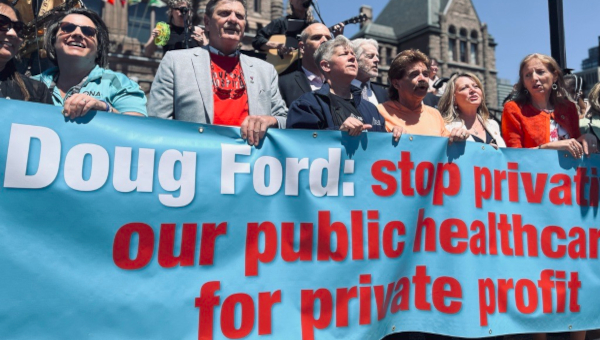Contrary to the hysteria from conservatives, health care spending continues to decline as a percentage of the provincial budget. Last year, health care accounted for 38.5 per cent of total expenditures, this year the government plans to bring it down to 38.3 per cent. This continues the trend downward since 2003/04 when health care accounted for 40 per cent of total expenditures.

The Ontario provincial Budget reports that program spending is going up an impressive sounding 2.99 per cent and health care spending is going up 2.3 per cent. Although that sounds like a larger than expected increase in these days of austerity, these figures are, unfortunately, misleading. The reason is that last year funding fell well short of the Budget plan and the government is now playing catch-up.
Austerity Redux
The 2013 Budget indicates that the government spent considerably less than it budgeted in the 2012 Budget. For example, the Ontario government spent $595-million less on health in 2012-13 than it budgeted, a 1.2 per cent reduction.
Overall, total spending was $2.4-billion less than budgeted – that is a decrease of just less than 1.9 per cent. Indeed, comparing Budgets, total interim expenditure in 2012-13 was actually $600-million less than total interim expenditure in 2011-12. This reduction is entirely accounted for by a reduction in program spending of $900-million (falling from $114.5-billion in the interim report for 2011-12 to $113.6-billion in the interim report for 2012-13).
| Summary of Medium-Term Expense Outlook | ||||
|---|---|---|---|---|
| $ Billions | Interim 2012-13 |
Plan 2013-14 |
Outlook 2014-15 |
Outlook 2015-16 |
| Health Sector | 47.8 | 48.9 | 49.8 | 50.8 |
| Education Sector | 22.4 | 24.1 | 24.6 | 24.8 |
| Post-secondary & Training | 7.4 | 7.7 | 7.8 | 7.8 |
| Children’s & Social Services | 13.8 | 14.3 | 15 | 15.2 |
| Justice Sector | 4 | 4.1 | 4.1 | 4.1 |
| Other Programs | 18.3 | 17.8 | 17 | 16.1 |
| Total Programs | 113.6 | 117 | 118.3 | 118.8 |
| % Increase | 2.99% | 1.11% | 0.42% | |
| Interest on Debt | 10.4 | 10.6 | 11.1 | 12.2 |
| Total Expense | 124 | 127.6 | 129.5 | 131 |
| Source: Budget Table 2.19 | ||||
The government plans more of the same tiny funding increases in the future.
Bottom line – the 2.99 per cent increase in program spending promised for this year is catch-up. With that increase we do equal the program spending planned for this year in last year’s Budget, but, given considerably lower than expected interest on debt, the total expenditure plan is actually $600-million less than planned in the 2012 Budget for 2013-14.
The 2013 Budget sets total spending only 1.1 per cent higher for 2013-14 than the 2012 Budget planned for 2012-13. Similarly, health care spending planned in the 2013 Budget for 2013-14 is only 1 per cent higher than planned in the 2012 Budget for 2012-13.

Health Care
The government sticks to its usual script on health care in the Budget:
- They will continue to move surgeries and procedures currently conducted in hospitals to specialized “not-for-profit” clinics. The government specifically sites colonoscopies, dialysis, and vision care (citing, in particular, expanded glaucoma and retina surgery at the Kensington Eye Institute).
- The Ontario Drug Benefit (ODB) program will become less and less universal by requiring higher-income senior ODB recipients to pay a larger share of their prescription drug costs starting in August 2014;
- Hospital base funding (i.e. funding for existing services) will continue to be frozen, but other pockets of money will be available, with a total funding increase of 1.7 per cent. The Budget adds that a 1 per cent increase in hospital funding equals $217-million, so this should equal $369-million in new hospital funding.
- Funding for “home and community care services” (however that is defined) will increase by 5 per cent – up from a promise of a 4 per cent increase last year (although whether that was delivered, who knows?). For what it’s worth, the Budget suggests 5 per cent increases will continue for 3 years. The government says it will be investing to reduce home care wait times for nursing services and improve personal support services for clients with complex care needs.
- Long-term care (LTC) homes will get a “two per cent annual increase in funding for direct resident care to address the increasingly complex care needs of patients.” Despite the rhetoric, there is no sign that the government will require LTC facilities to use this money to improve staffing levels through a legislated staffing standard.
- The government continues their promise of 23 “Health Links” to encourage greater collaboration to enable high-needs patients, such as seniors and people with complex conditions, receive more responsive care in the right place.
Collective Bargaining

The government claims that provincial public sector agreements are much lower than other sectors – i.e. private sector settlements, municipal settlements, and federal public sector settlements (see chart 1.24).
Indeed, the government headlines the claim “Bargaining Is Achieving Results and Protecting Services.”
The government does not say it will try to dictate results in collective bargaining (as the previous McGuinty/Duncan government tried to do), but proposes that compensation settlements should fit “within Ontario’s existing fiscal framework” and suggests that productivity improvements could be one way to achieve fiscal and service delivery goals:
“Going forward, compensation costs must be addressed within Ontario’s existing fiscal framework, which includes no funding for incremental compensation increases for new collective agreements. The government is confident that broader public sector partners can work together to achieve outcomes that remain within the fiscal plan while protecting services. In future rounds of bargaining, the government is willing to work with employers and bargaining agents to look at mechanisms such as productivity improvements as a way to achieve fiscal and service-delivery goals.” (My emphasis.)
Pensions
Aside from wages, the government also claims to have achieved huge reductions in pension expenses for employees in the broader provincial public sector. The government claims, extraordinarily, that their pension expenses will fall dramatically (see table below).
| Projected Pension Expense | ||||||
|---|---|---|---|---|---|---|
| 2012-13 | 2013 -14 |
2014 -15 |
2015 -16 |
2016 -17 |
2017 -18 |
|
| Current Forecast | 3.0 | 3.1 | 2.6 | 2.4 | 2.4 | 2.4 |
| 2012 Budget Forecast | 3.1 | 3.6 | ||||
| Difference in Forecast | -0.1 | -0.5 | ||||
| Drummond Commission | 3.1 | 3.7 | 3.6 | 3.7 | 4.0 | 4.2 |
| Difference in Forecast | -0.1 | -0.6 | -1 | -1.4 | -1.6 | -1.8 |
| Note: Numbers may not add due to rounding. Source 2013 Budget Table 1.3 and 2012 Budget Table 4.5. | ||||||
That’s $500-million savings in 2014-15 over this year’s pension expense and $700-million a year in the following years. At $700-million that is an incredible 22.6 per cent reduction in their pension expense compared with 2013-14. Indeed, compared to the pension expense they forecast in last year’s Budget ($3.6-billion in 2013-14), the annual savings by 2015-16 would be $1.2-billion. That would be a 33 per cent reduction on a $3.6-billion expense.
If the government’s figures are meaningful, even a $700-million savings would mean the government has saved about 1 per cent in compensation costs – before collective bargaining has even begun.
The Budget document also compares the current forecast with Don Drummond’s even higher forecast of pension expense – this is the same guy who suggested health care expenditures were headed to 70 per cent of spending when it has actually been heading back down to less than 40 per cent for some years. So – big surprise – Dummond’s figures are way off here as well •





